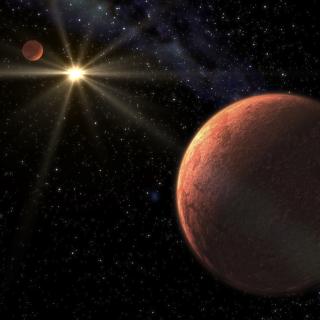Bibcode
Kaminski, A.; Trifonov, T.; Caballero, J. A.; Quirrenbach, A.; Ribas, I.; Reiners, A.; Amado, P. J.; Zechmeister, M.; Dreizler, S.; Perger, M.; Tal-Or, L.; Bonfils, X.; Mayor, M.; Astudillo-Defru, N.; Bauer, F. F.; Béjar, V. J. S.; Cifuentes, C.; Colomé, J.; Cortés-Contreras, M.; Delfosse, X.; Díez-Alonso, E.; Forveille, T.; Guenther, E. W.; Hatzes, A. P.; Henning, Th.; Jeffers, S. V.; Kürster, M.; Lafarga, M.; Luque, R.; Mandel, H.; Montes, D.; Morales, J. C.; Passegger, V. M.; Pedraz, S.; Reffert, S.; Sadegi, S.; Schweitzer, A.; Seifert, W.; Stahl, O.; Udry, S.
Referencia bibliográfica
Astronomy and Astrophysics, Volume 618, id.A115, 11 pp.
Fecha de publicación:
10
2018
Revista
Número de citas
50
Número de citas referidas
45
Descripción
Despite their activity, low-mass stars are of particular importance for
the search of exoplanets by the means of Doppler spectroscopy, as
planets with lower masses become detectable. We report on the discovery
of a planetary companion around HD 180617, a bright (J = 5.58 mag),
low-mass (M = 0.45M⊙) star of spectral type M2.5 V. The
star, located at a distance of 5.9 pc, is the primary of the high proper
motion binary system containing vB 10, a star with one of the lowest
masses known in most of the twentieth century. Our analysis is based on
new radial velocity (RV) measurements made at red-optical wavelengths
provided by the high-precision spectrograph CARMENES, which was designed
to carry out a survey for Earth-like planets around M dwarfs. The
available CARMENES data are augmented by archival Doppler measurements
from HIRES and HARPS. Altogether, the RVs span more than 16 yr. The
modeling of the RV variations, with a semi-amplitude of K =
2.85-0.25+0.16 m s-1, yields a
Neptune-like planet with a minimum mass of
12.2-1.4+1.0 M⊕ on a
105.90-0.10+0.09 d circumprimary orbit, which is
partly located in the host star's habitable zone. The analysis of time
series of common activity indicators does not show any dependence on the
detected RV signal. The discovery of HD 180617 b not only adds
information to a currently hardly filled region of the mass-period
diagram of exoplanets around M dwarfs, but the investigated system
becomes the third known binary consisting of M dwarfs and hosting an
exoplanet in an S-type configuration. Its proximity makes it an
attractive candidate for future studies.
The RV data (Table C.1) are only available at the CDS via anonymous ftp
to http://cdsarc.u-strasbg.fr
(http://130.79.128.5) or via http://cdsarc.u-strasbg.fr/viz-bin/qcat?J/A+A/618/A115
Proyectos relacionados

Estrellas de Baja Masa, Enanas Marrones y Planetas
Se investigan los procesos que conducen a la formación de estrellas de baja masa, enanas marrones y exoplanetas y caracterizar las propiedades físicas de estos astros en varias etapas evolutivas. Las estrellas de muy baja masa y las enanas marrones son probablemente los objetos más numerosos de nuestra Galaxia, pero no por ello están
Rafael
Rebolo López

Exoplanetas y Astrobiología
La búsqueda de vida en el Universo se ha visto impulsada por los recientes descubrimientos de planetas alrededor de otras estrellas (los llamados exoplanetas), convirtiéndose en uno de los campos más activos dentro de la Astrofísica moderna. En los últimos años los descubrimientos cada vez más numerosos de nuevos exoplanetas y los últimos avances
Enric
Pallé Bago